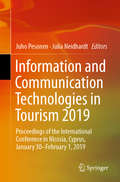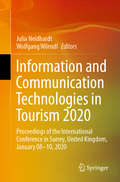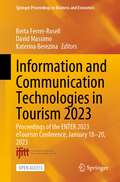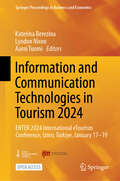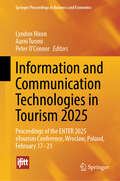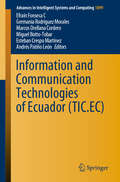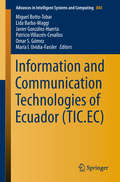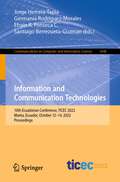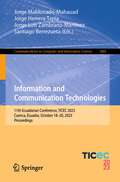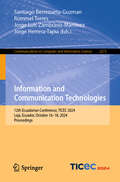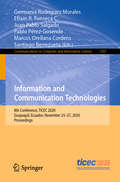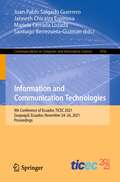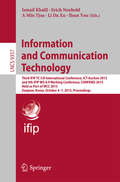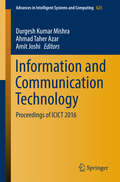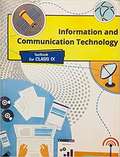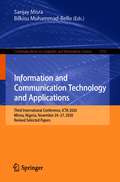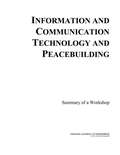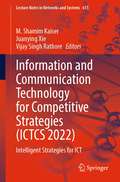- Table View
- List View
Information and Communication Technologies in Tourism 2014
by Zheng Xiang Iis TussyadiahThe papers presented in this volume advance the state-of-the-art research on social media and Web 2. 0, electronic tourism marketing, website development and evaluation, search engine marketing and optimization, IT adoption and diffusion, virtual travel communities, mobile technologies, management information systems in tourism, eLearning, recommender systems for tourism businesses and destinations and electronic distribution for hospitality and travel products. This book covers the most significant topics contributed by prominent scholars from around the world and is suitable for both academics and practitioners who are interested in the latest developments in e-Tourism.
Information and Communication Technologies in Tourism 2016
by Alessandro Inversini Roland ScheggThe papers presented in this volume advance thestate-of-the-art research on digital marketing and social media, mobile computingand responsive web design, semantic technologies and recommender systems,augmented and virtual reality, electronic distribution and online travelreviews, MOOC and eLearning, eGovernment and sharing economy. This book coversthe most significant areas contributed by prominent scholars from around theworld and is suitable for both academics and practitioners who are interestedin the latest developments in eTourism.
Information and Communication Technologies in Tourism 2019: Proceedings Of The International Conference In Nicosia, Cyprus, January 30 - February 1 2019
by Juho Pesonen Julia NeidhardtThis book provides an extensive, up-to-date overview of the ways in which information and communication technologies (ICTs) can be used to develop tourism and hospitality. The coverage encompasses a wide variety of topics within the field, including virtual reality, sharing economy and peer-to-peer accommodation, social media use, hotel technology, big data, robotics, and recommendation systems, to name but a few. The content is based on the 2019 ENTER eTourism conference, organized in Nicosia, Cyprus by the International Federation for Information Technologies and Travel & Tourism (IFITT) – the leading independent global community for the discussion, exchange, and development of knowledge on the use and impact of new ICTs in the travel and tourism industry. The book offers a global perspective and rich source of information on important innovations and novel ideas. Though it will prove especially valuable for academics working in the eTourism field, it will also be of considerable interest to practitioners and students.
Information and Communication Technologies in Tourism 2020: Proceedings of the International Conference in Surrey, United Kingdom, January 08–10, 2020
by Julia Neidhardt Wolfgang WörndlGathering the outcomes of the 27th annual international eTourism conference ENTER2020, this book presents new research, innovative systems and industry case studies on the application of Information and Communication Technologies (ICT) in travel and tourism. It shares the latest findings discussed at the conference and highlights various topics within the field, including social media, destination marketing, recommender systems and decision-making, virtual and augmented reality, technology in tourism, and research on hotels and activities. Readers will find a wealth of state-of-the-art insights and ideas on how information and communication technologies can be applied in travel and tourism.
Information and Communication Technologies in Tourism 2023: Proceedings of the ENTER 2023 eTourism Conference, January 18-20, 2023 (Springer Proceedings in Business and Economics)
by Berta Ferrer-Rosell David Massimo Katerina BerezinaThis open access book provides an extensive overview of the usage of information and communication technologies in the tourism and hospitality industry. It presents the proceedings of the International Federation for IT and Travel & Tourism (IFITT)’s 30th Annual International eTourism Conference, which assembles the latest research presented at the ENTER2023 conference. The enclosed papers cover various topics within the field, including augmented and virtual reality, website development, social media use, e-learning, big data, analytics and recommendation systems.
Information and Communication Technologies in Tourism 2024: ENTER 2024 International eTourism Conference, Izmir, Türkiye, January 17-19 (Springer Proceedings in Business and Economics)
by Lyndon Nixon Katerina Berezina Aarni TuomiFor more than 30 years, Information and Communication Technology (ICT) has been revolutionizing travel, tourism, and hospitality, and as we look to the next 30 years, the change of pace does not seem to be diminishing. This open-access book provides an extensive overview of the latest developments of ICTs in the tourism and hospitality industry. Featuring papers presented at the International Federation for IT and Travel & Tourism’s (IFITT) 31st annual ENTER International eTourism Conference (ENTER24) held in Izmir, Türkiye, this book presents research on topics such as artificial general intelligence (AGI) in tourism and hospitality; emerging technologies in tourism education; virtual reality; technologies for sustainability, health and wellbeing; big data and analytics, among others. This is an open access book.
Information and Communication Technologies in Tourism 2025: Proceedings of the ENTER 2025 eTourism Conference, Wroclaw, Poland, February 17–21 (Springer Proceedings in Business and Economics)
by Peter O'Connor Lyndon Nixon Aarni TuomiThis book provides an extensive overview of the latest developments in information and communication technologies (ICTs) in the tourism and hospitality industry. Featuring papers presented at the International Federation for IT and Travel & Tourism’s (IFITT) 32nd annual ENTER International eTourism Conference (ENTER25) held in Wroclaw, Poland, this book examines the future of the tourism and hospitality industry and the impact ICTs such as generative AI, robotics, and Internet of things (IoT) has in creating a sustainable future for the industry. Information and communication technologies (ICTs) continue to revolutionize travel, tourism, and hospitality. Over 30+ years, the ENTER eTourism conference has been at the forefront of providing insight on the use and impact of new technologies for travel, tourism and hospitality practitioners and researchers. However, the rapid development and deployment of new developments, including generative AI (GenAI), service robotics, IoT, and Extended Realities (XR) technologies, among others, call for a rapid and careful reassessment of ICT in tourism, particularly including ethical and societal considerations. Examining the answer to questions such as how can technology help businesses and organizations be more agile, innovative, and resilient in difficult times; what role does technology play in driving sustainable development; how emerging technologies impact customer and employee experiences, and how challenges and dangers presented by technological disruption can be addressed, this book is valuable to scholars, researchers, students, and practitioners in tourism and hospitality.
Information and Communication Technologies of Ecuador (Advances in Intelligent Systems and Computing #1099)
by Miguel Botto-Tobar Efraín Fonseca C Germania Rodríguez Morales Marcos Orellana Cordero Esteban Crespo Martínez Andrés Patiño LeónThis book constitutes the proceedings of the Sixth Conference on Information and Communication Technologies “TIC.EC”, held in Cuenca, Ecuador, from November 27 to 29, 2019. Considered one of the most important conferences on ICT in Ecuador, it brings together scholars and practitioners from the country and abroad to discuss the development, issues and projections of the use of information and communication technologies in multiples fields of application. The 2019 “TIC.EC” conference was organized by Universidad del Azuay (UDA) and its Engineering School, as well as the Ecuadorian Corporation for the Development of Research and Academia (CEDIA). The book covers the following topics:· Software engineering· Security· Data· Networks· Architecture· Applied ICTs· Technological entrepreneurship· Links between research and industry· High-impact innovation· Knowledge management and intellectual property
Information and Communication Technologies of Ecuador (Advances in Intelligent Systems and Computing #884)
by Miguel Botto-Tobar Lida Barba-Maggi Javier González-Huerta Patricio Villacrés-Cevallos Omar S. Gómez María I. Uvidia-FasslerThis book constitutes the proceedings of the 6th Conference on Information Technologies and Communication of Ecuador “TIC-EC”, held in Riobamba City from November 21 to 23, 2018, and organized by Universidad Nacional del Chimborazo (UNACH) and its Engineering School, and the Ecuadorian Corporation for the Development of Research and Academia (CEDIA). Considered as one of the most important ICT conferences in Ecuador, it brought together international scholars and practitioners to discuss the development, issues and projections of the use of information and communication technologies in multiple fields of application.Presenting high-quality, peer-reviewed papers, the book discusses the following topics:• Communication networks• Software engineering• Computer sciences• Architecture• Intelligent territory management• IT management• Web technologies• ICT in education• Engineering, industry, and construction with ICT support• Entrepreneurship and innovation at the Academy: a business perspectiveThe authors would like to express their sincere gratitude to the invited speakers for their inspirational talks, to the authors for submitting their work to this conference, and the reviewers for sharing their experience during the selection process.
Information and Communication Technologies: 10th Ecuadorian Conference, TICEC 2022, Manta, Ecuador, October 12–14, 2022, Proceedings (Communications in Computer and Information Science #1648)
by Efraín R. Fonseca C. Santiago Berrezueta-Guzman Jorge Herrera-Tapia Germania Rodriguez-MoralesThis book constitutes refereed proceedings of the 10th Ecuadorian Conference on Information and Communication Technologies, TICEC 2022, held in Manta, Ecuador, in October 2022.The 20 full papers were carefully reviewed and selected from 150 qualified submissions. The papers cover a great variety of topics, such as wireless communication, immersive environments, artificial intelligence, data mining, neural networks, augmented reality, cyberphysical systems, telemedicine, cybersecurity, software architecture, data processing, software development, and others. The contributions are divided into the following thematic blocks: ICT´s Applications; Data Science; Software Development.
Information and Communication Technologies: 11th Ecuadorian Conference, TICEC 2023, Cuenca, Ecuador, October 18–20, 2023, Proceedings (Communications in Computer and Information Science #1885)
by Santiago Berrezueta Jorge Herrera-Tapia Jorge Maldonado-Mahauad Jorge Luis Zambrano-MartínezThis book constitutes the proceedings of the 11th Ecuadorian Conference on Information and Communication Technologies, TICEC 2023, held in Cuenca, Ecuador, during October 18–20, 2023.The 31 full papers presented were carefully reviewed and selected from 120 submissions. The papers cover a great variety of topics, such as internet of things, cyber-physical systems, human-machine interface, artificial Intelligence, e-Learning, smart healthcare, smart healthcare and others. The papers are organized in the following topical sections: data science and machine learning; ICTs and their applications; and software development.
Information and Communication Technologies: 12th Ecuadorian Conference, TICEC 2024, Loja, Ecuador, October 16–18, 2024, Proceedings (Communications in Computer and Information Science #2273)
by Santiago Berrezueta-Guzman Jorge Herrera-Tapia Rommel Torres Jorge Luis Zambrano-MartinezThis book constitutes the refereed proceedings of the 12th Ecuadorian Conference on Information and Communication Technologies, TICEC 2024, held in Loja, Ecuador, during October 16–18, 2024. The 24 full papers presented here were carefully reviewed and selected from 74 submissions. They were organized in the following topical sections: Image Processing, Classification, and Segmentation; Artificial Intelligence and Machine Learning Applications; IoT, Embedded Systems, and Applications in Healthcare and Industrial Environments.
Information and Communication Technologies: 8th Conference, TICEC 2020, Guayaquil, Ecuador, November 25–27, 2020, Proceedings (Communications in Computer and Information Science #1307)
by Marcos Orellana Cordero Germania Rodriguez Morales Efraín R. Fonseca C. Juan Pablo Salgado Pablo Pérez-Gosende Santiago BerrezuetaThis book constitutes refereed proceedings of the 8th Conference on Information and Communication Technologies of Ecuador, TICEC 2020, held in November 2020. Due to the COVID-19 pandemic the conference was held online. The 36 full and 7 short papers were carefully reviewed and selected from 117 qualified submissions. The papers are organized according to the following topical sections: biomedical sensors and wearables systems; data science; ICT´s applications; industry 4.0; smart cities; software development; technology and environment.
Information and Communication Technologies: 9th Conference of Ecuador, TICEC 2021, Guayaquil, Ecuador, November 24–26, 2021, Proceedings (Communications in Computer and Information Science #1456)
by Juan Pablo Salgado Guerrero Janneth Chicaiza Espinosa Mariela Cerrada Lozada Santiago Berrezueta-GuzmanThis book constitutes refereed proceedings of the 9th Conference on Information and Communication Technologies of Ecuador, TICEC 2021, held at the Universidad Politécnica Salesiana (UPS) campus in November 2021. The conference was organized in hybrid mode.The 24 full papers were carefully reviewed and selected from 126 qualified submissions. The papers cover a great variety of topics, such as data mining, neural networks, cyberphysical systems, telemedicine, traffic simulation, geospatial information, human–machine interaction, cloud computing, and others. The contributions are divided into the following thematic blocks: Data Science, ICT´s Applications, Industry 4.0, Technology and Environment, Biomedical Sensors and Wearables Systems.
Information and Communication Technology
by Ismail Khalil Erich Neuhold A Min Tjoa Li Da Xu Ilsun YouThis book constitutes the refereed proceedings of the Third IFIP TC 5/8 International Conference on Information and Communication Technology, ICT-EurAsia 2015, with the collocation of AsiaARES 2015 as a special track on Availability, Reliability and Security, and the 9th IFIP WG 8. 9 Working Conference on Research and Practical Issues of Enterprise Information Systems, CONFENIS 2015, held as part of the 23rd IFIP World Computer Congress, WCC 2015, in Daejeon, Korea, in October 2015. The 35 revised full papers presented were carefully reviewed and selected from 84 submissions. The papers have been organized in the following topical sections: networks and systems architecture; teaching and education; authentication and profiling; data management and information advertizing; applied modeling and simulation; network security; dependable systems and applications, multimedia security; cryptography; big data and text mining, and social impact of EIS and visualization.
Information and Communication Technology
by Ahmad Taher Azar Amit Joshi Durgesh Kumar MishraThis volume includes 73 papers presented at ICTIS 2017: Second International Conference on Information and Communication Technology for Intelligent Systems. The conference was held on 25th and 26th March 2017, in Ahmedabad, India and organized jointly by the Associated Chambers of Commerce and Industry of India (ASSOCHAM) Gujarat Chapter, the G R Foundation, the Association of Computer Machinery, Ahmedabad Chapter and supported by the Computer Society of India Division IV - Communication and Division V - Education and Research. The papers featured mainly focus on information and communications technology (ICT) and its applications in intelligent computing, cloud storage, data mining and software analysis. The fundamentals of various data analytics and algorithms discussed are useful to researchers in the fiel d.
Information and Communication Technology (ICT) class 9 - NCERT - 23
by National Council of Educational Research and TrainingThe NCERT textbook "Information and Communication Technology" for Class IX provides a comprehensive overview of key concepts and principles in the field of ICT. Covering topics ranging from the basics of computer hardware and software to more advanced concepts such as networking, internet technologies, and cybersecurity, this textbook aims to equip students with the knowledge and skills needed to navigate the rapidly evolving digital landscape. Through engaging examples, illustrations, and practical exercises, students are encouraged to develop a deeper understanding of ICT and its applications in various domains. Emphasizing critical thinking and problem-solving skills, the textbook also highlights the ethical and societal implications of ICT, encouraging students to use technology responsibly and ethically. Overall, "Information and Communication Technology" serves as an invaluable resource for students seeking to develop a strong foundation in ICT and prepare for the digital challenges of the modern world.
Information and Communication Technology and Applications: Third International Conference, ICTA 2020, Minna, Nigeria, November 24–27, 2020, Revised Selected Papers (Communications in Computer and Information Science #1350)
by Sanjay Misra Bilkisu Muhammad-BelloThis book constitutes revised selected papers from the Third International Conference on Information and Communication Technology and Applications, ICTA 2020, held in Minna, Nigeria, in November 2020. Due to the COVID-19 pandemic the conference was held online. The 67 full papers were carefully reviewed and selected from 234 submissions. The papers are organized in the topical sections on Artificial Intelligence, Big Data and Machine Learning; Information Security Privacy and Trust; Information Science and Technology.
Information and Communication Technology and Peacebuilding: July 2008
by National Academy of Engineering of the National AcademiesThose who would use information and communication technology (ICT) in the cause of peace need to be cognizant of the risks as well as the benefits. ICT can facilitate positive dialogue but also hate speech. It can be used to fight corruption but also facilitate it. Simply giving people more information does not necessarily lead to predictable or positive results. As people become more informed, they may become more motivated to change their circumstances and to do so violently. On December 14, 2007, the National Academy of Engineering (NAE) convened a group of experts in diverse fields to consider the role of ICT in promoting peace and conflict resolution. The one-day workshop was designed to consider current and emerging technologies and strategies for employing them in conflict management and diplomacy. It also aimed to explore how organizations with a role in promoting peace, like the U.S. Institute of Peace, can most effectively leverage technology in carrying out their missions. Information and Communication Technology and Peacebuilding: Summary of a Workshop reviews the group’s discussions on number of key issues, illuminates certain practitioner needs, and suggests possible next steps.
Information and Communication Technology for Competitive Strategies: ICT: Applications and Social Interfaces (Lecture Notes in Networks and Systems #191)
by Amit Joshi Nileshsingh V. Thakur Mufti Mahmud Roshan G. RagelThis book contains the best selected research papers presented at ICTCS 2020: Fifth International Conference on Information and Communication Technology for Competitive Strategies. The conference was held at Jaipur, Rajasthan, India, during 11–12 December 2020. The book covers state-of-the-art as well as emerging topics pertaining to ICT and effective strategies for its implementation for engineering and managerial applications. This book contains papers mainly focused on ICT for computation, algorithms and data analytics, and IT security.
Information and Communication Technology for Competitive Strategies: ICT: Applications and Social Interfaces (Lecture Notes in Networks and Systems #400)
by Amit Joshi Mufti Mahmud Roshan G. RagelThis book contains best selected research papers presented at ICTCS 2021: Sixth International Conference on Information and Communication Technology for Competitive Strategies. The conference will be held at Jaipur, Rajasthan, India, during December 17–18, 2021. The book covers state-of-the-art as well as emerging topics pertaining to ICT and effective strategies for its implementation for engineering and managerial applications. This book contains papers mainly focused on ICT for computation, algorithms and data analytics, and IT security. The book is presented in two volumes.
Information and Communication Technology for Competitive Strategies: ICT: Applications and Social Interfaces (Lecture Notes in Networks and Systems #623)
by Amit Joshi Mufti Mahmud Roshan G. RagelThis book contains best selected research papers presented at ICTCS 2022: Seventh International Conference on Information and Communication Technology for Competitive Strategies. The conference will be held in Chandigarh, India during 9 – 10 December 2022. The book covers state-of-the-art as well as emerging topics pertaining to ICT and effective strategies for its implementation for engineering and managerial applications. This book contains papers mainly focused on ICT for computation, algorithms and data analytics and IT security. The work is presented in two volumes.
Information and Communication Technology for Competitive Strategies: Intelligent Strategies for ICT (Lecture Notes in Networks and Systems #190)
by Vijay Singh Rathore M. Shamim Kaiser Juanying XieThis book contains the best selected research papers presented at ICTCS 2020: Fifth International Conference on Information and Communication Technology for Competitive Strategies. The conference was held at Jaipur, Rajasthan, India during 11–12 December 2020. The book covers state-of-the-art as well as emerging topics pertaining to ICT and effective strategies for its implementation for engineering and managerial applications. This book contains papers mainly focused on ICT for computation, algorithms and data analytics and IT security.
Information and Communication Technology for Competitive Strategies: Intelligent Strategies for ICT (Lecture Notes in Networks and Systems #401)
by Vijay Singh Rathore M. Shamim Kaiser Juanying XieThis book contains best selected research papers presented at ICTCS 2021: Sixth International Conference on Information and Communication Technology for Competitive Strategies. The conference will be held at Jaipur, Rajasthan, India, during December 17–18, 2021. The book covers state-of-the-art as well as emerging topics pertaining to ICT and effective strategies for its implementation for engineering and managerial applications. This book contains papers mainly focused on ICT for computation, algorithms and data analytics, and IT security. The book is presented in two volumes.
Information and Communication Technology for Competitive Strategies: Intelligent Strategies for ICT (Lecture Notes in Networks and Systems #615)
by Vijay Singh Rathore M. Shamim Kaiser Juanying XieThis book contains best selected research papers presented at ICTCS 2022: Seventh International Conference on Information and Communication Technology for Competitive Strategies. The conference will be held in Chandigarh, India, during December 9–10, 2022. The book covers state-of-the-art as well as emerging topics pertaining to ICT and effective strategies for its implementation for engineering and managerial applications. This book contains papers mainly focused on ICT for computation, algorithms and data analytics and IT security. The work is presented in two volumes.


